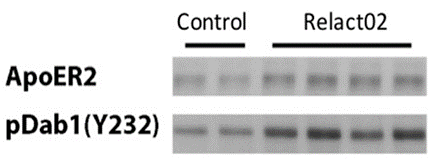Advantages:
- Small, soluble drug with therapeutic potential
- Independent Reelin signaling pathway activation
- More able to pass through the BBB than Reelin
Summary:
The Reelin signaling pathway is an essential component of the developing and adult central nervous systems. The signaling cascade assists with the regulation of developing neurons including their migration and positioning patterns and is also understood to play a role in learning and memory. Reelin, a glycoprotein produced in the body, is known to initiate the Reelin signaling cascade. It then binds to receptors apolipoprotein E receptor 2 (ApoER2) and very-low-density lipoprotein receptor (VLDLR). Both of these receptors interact with Dab1, which continues to activate a series of other components in the pathway’s signaling system. Considering its role in the central nervous system and its association with the Alzheimer's disease risk gene, apoE, ApoER2 is assumed to be involved in the disease, although its exact role is unclear. Disruption of the Reelin signaling pathway has been shown to be a factor in many disorders and diseases such as Alzheimer’s disease, Angelman syndrome, Schizophrenia, and Bipolar Disorder. Furthermore, a lack of ApoER2 has been shown in brain tissue analyses of patients with Alzheimer’s disease.
Our researchers have discovered a small molecule named Relact02 that is able to activate ApoER2 and the Reelin signaling pathway without the presence of Reelin. Reelin is a large molecule and, consequently, has difficulty passing through the Blood Brain Barrier (BBB). Relact02 is a smaller and more soluble molecule and could therefore be utilized with greater success as a drug for various neurological diseases.

Cultures show increases in ApoER2 and Dab-1 when treated with Relact02, which are both components of the reelin signaling pathway.
Desired Partnerships: